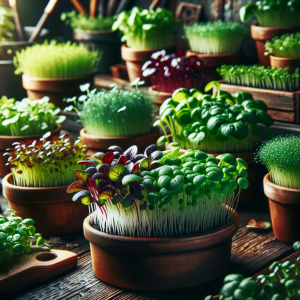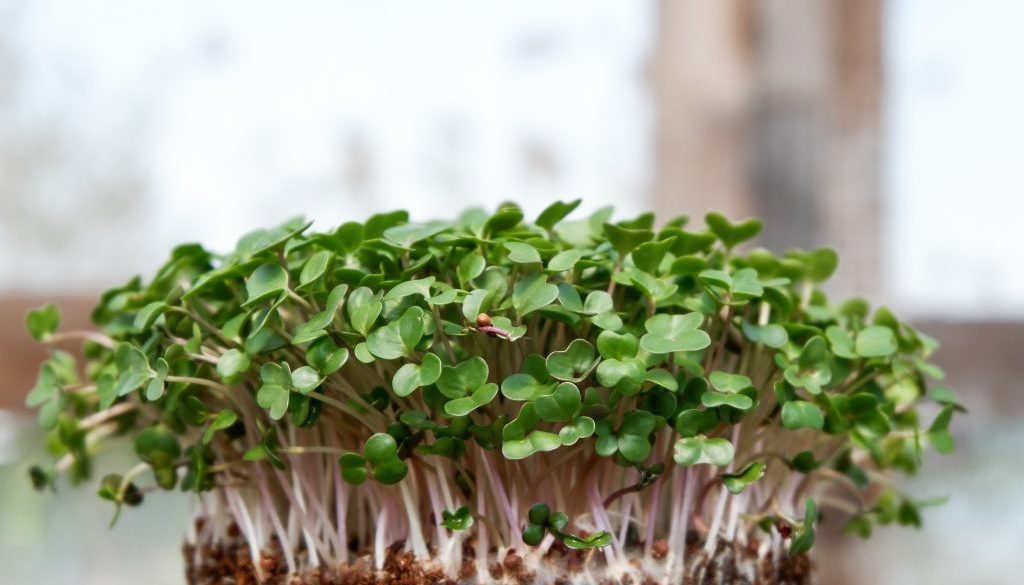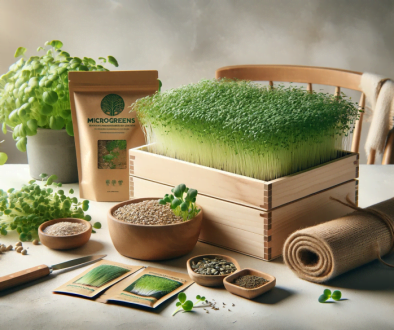Microgreens have gained popularity for their exceptional nutritional density and versatility in culinary applications. These tiny, tender greens, harvested at an early stage of growth, offer a multitude of health benefits and a burst of flavors to elevate your dishes.
In this comprehensive guide, we’ll delve into lesser-known facts about microgreens, explore their diverse varieties, discuss their cultivation, and highlight their significant health advantages.
Key Points (TLDR)
The nutritional powerhouse
- Nutrient density: Microgreens are renowned for their exceptional nutrient density. Research has demonstrated that they contain concentrations of vitamins, minerals, and antioxidants that surpass those found in mature plant leaves. Even small quantities of microgreens can provide significant nutritional value to your diet.
- Enzyme-rich: Microgreens are rich in enzymes crucial for food digestion and nutrient absorption. These enzymes aid in breaking down food and facilitate the absorption of vitamins and minerals in the body.
- Diverse flavors: Microgreens come in a variety of flavors, such as parsley, coriander, radish, broccoli, spinach, and many more. Each variety offers a unique taste, allowing for culinary creativity and diversity in your meals.
- Ease of cultivation: Growing microgreens is a straightforward process that can be done at home or in a small space. They can be cultivated in containers, trays, or hydroponic systems. Their rapid growth allows for quick access to fresh and homegrown microgreens.
- Sustainability: Microgreens require less water, space, and time compared to cultivating mature plants. This makes them an eco-friendly choice, reducing the ecological footprint and enabling food production in urban environments.
- Creative use: Microgreens are incredibly versatile and can be incorporated into various dishes, including salads, sandwiches, soups, smoothies, sauces, or used as garnishes. Additionally, they can be dried or turned into powder to extend their shelf life and use in different forms.
- Immune boost: Thanks to their high content of vitamins C, E, and other antioxidants, microgreens can support the immune system, combat free radicals, and enhance overall immunity.
Popular microgreens and cultivation tips
Let’s take a closer look at some of the most popular microgreen varieties and how to grow them at home:
- Radish microgreens
- Flavor: Spicy and peppery
- Typical Uses: Salads, sandwiches, wraps, and garnishes
- Cultivation: Soil or coconut coir substrate, with 12-16 hours of daily light
- Harvest: 6-10 days
- Seed Density: 10-12 grams per 100 cm2 (25-30% coverage)
- Yield: 100-120 grams per 100 cm2
- Broccoli microgreens
- Flavor: Mild, slightly bitter, and earthy
- Typical Uses: Salads, smoothies, and garnishes
- Cultivation: Soil or coconut coir substrate, with 12-16 hours of daily light
- Harvest: 7-14 days
- Seed Density: 8-10 grams per 100 cm2 (20-25% coverage)
- Yield: 60-80 grams per 100 cm2
- Sunflower microgreens
- Flavor: Nutty and crunchy
- Typical Uses: Salads, sandwiches, and wraps
- Cultivation: Soil or coconut coir substrate, with 12-16 hours of daily light
- Harvest: 10-14 days
- Seed Density: 12-14 grams per 100 cm2 (30-35% coverage)
- Yield: 150-200 grams per 100 cm2
- Pea microgreens
- Flavor: Sweet and slightly grassy
- Typical Uses: Salads, sautéed dishes, and sandwiches
- Cultivation: Soil or coconut coir substrate, with 12-16 hours of daily light
- Harvest: 10-14 days
- Seed Density: 15-20 grams per 100 cm2 (35-45% coverage)
- Yield: 200-250 grams per 100 cm2
- Arugula microgreens
- Flavor: Nutty and peppery
- Typical Uses: Salads, sandwiches, and decoration
- Cultivation: Soil or coconut coir substrate, with 12-16 hours of daily light
- Harvest: 7-10 days
- Seed Density: 5-7 grams per 100 cm2 (15-20% coverage)
- Yield: 60-80 grams per 100 cm2
- Beet microgreens
- Flavor: Earthy and slightly sweet
- Typical Uses: Salads, smoothies, and decoration
- Cultivation: Soil or coconut coir substrate, with 12-16 hours of daily light
- Harvest: 10-14 days
- Seed Density: 6-8 grams per 100 cm2 (20-25% coverage)
- Yield: 70-90 grams per 100 cm2
- Kale microgreens
- Flavor: Mildly sweet and slightly bitter
- Typical Uses: Salads, smoothies, and garnishes
- Cultivation: Soil or coconut coir substrate, with 12-16 hours of daily light
- Harvest: 7-12 days
- Seed Density: 5-7 grams per 100 cm2 (15-20% coverage)
- Yield: 60-80 grams per 100 cm2
Cultivating microgreens
 Microgreen cultivation is the process of growing various plant species to an early stage of development, typically when the plants have just sprouted from their seeds and developed their initial leaves. Microgreens can be grown in any space with sufficient light, enhancing flavors and nutritional value.
Microgreen cultivation is the process of growing various plant species to an early stage of development, typically when the plants have just sprouted from their seeds and developed their initial leaves. Microgreens can be grown in any space with sufficient light, enhancing flavors and nutritional value.
The growing process is relatively simple. Seeds are sown onto special substrates such as coconut coir, perlite, vermiculite, or hemp substrate. These trays are kept in a well-lit and humid environment. Within approximately 7-14 days, the seeds will sprout and develop their first leaves.
Microgreens can be cultivated from various plant species, including parsley, arugula, radish, kale, peas, and many more. Each type of microgreen offers a unique flavor and nutritional profile, making them a popular decorative addition to dishes or a healthy dietary supplement.
Advantages of microgreen cultivation include rapid growth, ease of cultivation, high nutritional content, and year-round growth possibilities. Furthermore, microgreens are rich in vitamins, minerals, and antioxidants, making them a valuable dietary addition.
Cultivating microgreens is an eco-friendly way of growing food since it can be done indoors without the need for excessive water, pesticides, or fertilizers. This makes microgreens an ideal choice for those looking to grow their own food at home or in urban settings.
The importance of microgreens in urban agriculture
Urban agriculture is becoming increasingly important as more people move to cities, resulting in limited access to fresh and locally grown produce. Microgreens play a significant role in urban agriculture for several reasons:
- Space-Efficient: Microgreens can be grown in small spaces, making them ideal for urban environments with limited room for traditional gardening.
- Rapid Growth: These greens grow quickly and can be harvested within 7-14 days, ensuring a steady supply of fresh produce.
- Year-Round Cultivation: Microgreens can be grown indoors, allowing for year-round cultivation, regardless of the weather outside.
- Low Water Usage: Microgreens require less water compared to full-sized crops, making them a sustainable choice for urban farming.
- Reduced Food Miles: Cultivating microgreens locally reduces the distance food needs to travel, which lowers the carbon footprint and ensures freshness.
- Educational Value: Growing microgreens can be an educational activity for urban dwellers, teaching them about sustainable agriculture and nutrition.
- Market Potential: Many urban farmers find success in selling microgreens to local restaurants, farmers’ markets, and directly to consumers, creating economic opportunities.
Urban agriculture, with microgreens as a focal point, addresses food security, sustainability, and the utilization of underutilized urban spaces. It empowers urban communities to take control of their food sources, promote healthy eating, and reduce their environmental impact.
How to grow your own microgreens
Growing microgreens at home is a simple and rewarding process. Here’s a step-by-step guide to help you get started:
Materials needed:
- Microgreen seeds of your choice
- A shallow tray or container
- A sterile growing medium (such as soil, coconut coir, or vermiculite)
- Light source (natural sunlight or LED grow lights)
- A spray bottle for watering
- A clear plastic lid or plastic wrap (optional)
- Ventilation (optional, to prevent mold)
Steps:
- Select your seeds: Choose the microgreen varieties you want to grow. Common options include arugula, radish, broccoli, and kale. You can find microgreen seeds at gardening stores or online.
- Prepare the tray: Fill your shallow tray or container with a sterile growing medium. Make sure it’s moist but not waterlogged.
- Sow the seeds: Sprinkle the seeds evenly over the surface of the growing medium. Depending on the variety, you can use different seeding densities (as mentioned in the specific growing tips earlier).
- Cover (optional): You can cover the tray with a clear plastic lid or plastic wrap to create a mini greenhouse effect. This helps maintain humidity levels. Alternatively, you can leave the tray uncovered and use a spray bottle to keep the surface moist.
- Provide light: Place the tray in a location with sufficient light. If you’re not using natural sunlight, LED grow lights are an excellent choice. Microgreens need 12-16 hours of light per day.
- Watering: Mist the surface with a spray bottle to keep it consistently moist. Be careful not to overwater, as this can lead to mold growth.
- Ventilation (optional): To prevent mold, consider providing some ventilation by propping the lid or plastic wrap slightly open.
- Growth and harvest: In about 7-14 days, depending on the variety, your microgreens will be ready for harvest. Use scissors to cut the microgreens just above the soil line.
- Enjoy your harvest: Use your fresh microgreens in salads, sandwiches, smoothies, or as garnishes. Store any excess in the refrigerator for a short period.
Growing microgreens at home is a rewarding and cost-effective way to enjoy fresh, nutritious greens. Experiment with different varieties to discover your favorite flavors.
Microgreens offer a powerful combination of nutritional density, culinary versatility, and ease of cultivation. These tiny greens pack a significant punch in terms of vitamins, minerals, and antioxidants, making them a valuable addition to a healthy diet. Furthermore, their straightforward cultivation process, low space requirements, and minimal environmental impact make them an essential component of urban agriculture.
By growing microgreens at home or supporting local urban agriculture initiatives, you can enhance your culinary creations, boost your health, and contribute to a more sustainable and resilient food system. Whether you’re an aspiring home gardener or a seasoned chef, microgreens have something to offer, from their vibrant flavors to their impressive nutritional benefits.
So, roll up your sleeves, grab your seeds, and start cultivating these mini powerhouses to elevate your meals and your well-being. Your journey into the world of microgreens promises a rewarding and nutritious experience.




